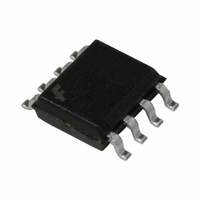FAN6520AIMX Fairchild Semiconductor, FAN6520AIMX Datasheet - Page 6

FAN6520AIMX
Manufacturer Part Number
FAN6520AIMX
Description
IC CTRLR PWM SGL SYNC BUCK 8SOIC
Manufacturer
Fairchild Semiconductor
Type
Step-Down (Buck)r
Datasheet
1.FAN6520AMX.pdf
(15 pages)
Specifications of FAN6520AIMX
Internal Switch(s)
No
Synchronous Rectifier
Yes
Number Of Outputs
1
Voltage - Output
0.8 ~ 5.5 V
Frequency - Switching
300kHz
Voltage - Input
4.5 ~ 5.5 V
Operating Temperature
-40°C ~ 85°C
Mounting Type
Surface Mount
Package / Case
8-SOIC (3.9mm Width)
Power - Output
715mW
Topology
Boost, Buck
Output Voltage
0.8 V to 5.5 V
Switching Frequency
340 KHz
Duty Cycle (max)
100 %
Operating Supply Voltage
5 V
Maximum Operating Temperature
+ 85 C
Minimum Operating Temperature
- 40 C
Mounting Style
SMD/SMT
Synchronous Pin
No
Lead Free Status / RoHS Status
Lead free / RoHS Compliant
Current - Output
-
Lead Free Status / Rohs Status
Lead free / RoHS Compliant
©2005 Fairchild Semiconductor Corporation
FAN6520A Rev. 1.0.5
Circuit Description
Initialization
The FAN6520A automatically initializes upon receipt of
power. The Power-On Reset (POR) function continually
monitors the bias voltage at the VCC pin. When the sup-
ply voltage exceeds its POR threshold, the IC initiates
the Over-Current Protection (OCP) sample-and-hold
operation. Upon completion of the OCP sample-and-hold
operation, the POR function initiates soft-start operation.
Over-Current Protection
The over-current function protects the converter from a
shorted output by using the upper MOSFET’s on-resis-
tance, R
enhances the converter’s efficiency and reduces cost by
eliminating the need for a current-sensing resistor. The
over-current function cycles the soft-start function in a
hiccup mode to provide fault protection. A resistor (R
SET
Application diagram). Immediately following POR, the
FAN6520A initiates the Over-Current Protection sam-
pling-and-hold operation. First, the internal error ampli-
fier is disabled. This allows an internal 20µA current sink
to develop a voltage across R
then samples this voltage at the COMP pin. This sam-
pled voltage, which is referenced to the VCC pin, is held
internally as the over-current set point. When the voltage
across the upper MOSFET, which is also referenced to
the VCC pin, exceeds the over-current set point, the
over-current function initiates a soft-start sequence. Fig-
ure 3 shows the inductor current after a fault is intro-
duced while running at 15A. The continuous fault causes
the FAN6520A to go into a hiccup mode with a typical
period of 25ms. The inductor current increases to 18A
during the soft-start interval and causes an over-current
trip. The converter dissipates very little power with this
method. The measured input power for the conditions
shown in Figure 3 is 1.5W.
) programs the over-current trip level (see Typical
DS(ON)
Figure 3. Over-Current Operation
OUTPUT INDUCTOR
, to monitor the current. This method
CURRENT
5A/DIV.
OCSET
. The FAN6520A
OC-
The over-current function trips at a peak inductor current
(I
where I
(20µA typical). The OC trip point varies mainly due to the
MOSFET’s R
tripping in the normal operating load range, find the R
SET
• The maximum R
• The minimum I
• Determine I
For an equation for the ripple current, see “Output Induc-
tor (L
Internal circuitry of the FAN6520A does not recognize a
voltage drop across R
age drop across R
current trip point to:
An over-current trip cycles the soft-start function.
Soft-Start
The POR function initiates the soft-start sequence after
the over-current set point has been sampled. Soft-start
clamps the error amplifier output (COMP pin) and refer-
ence input (noninverting terminal of the error amp) to the
internally generated soft-start voltage. Figure 4 shows a
typical start-up interval where the COMP/OCSET pin has
been released from a grounded (system shutdown)
state. Initially, the COMP/OCSET is used to sample the
over-current set point by disabling the error amplifier and
drawing 20µA through R
level has been sampled, the soft-start function is initi-
ated. The clamp on the error amplifier (COMP/OCSET
pin) initially controls the converter’s output voltage during
soft-start. The oscillator’s triangular waveform is com-
pared to the ramping error amplifier voltage. This gener-
ates SW pulses of increasing width that charge the
output capacitor(s). When the internally generated soft-
start voltage exceeds the feedback (FB pin) voltage, the
output voltage is in regulation. This method provides a
rapid and controlled output voltage rise. The entire start-
up sequence typically takes about 11ms.
I
I
PEAK
PEAK
PEAK
6
temperature
where ΔI is the output inductor ripple current.
resistor from the equation above with:
out
) determined by:
=
)” under Component Selection.
=
OCSET
----------------------
R
I
-----------------------------------------------
OCSET
DS ON
0.5V
DS(ON)
PEAK
(
R
is the internal OCSET current source
DS ON
OCSET
)
×
OCSET
DS(ON)
(
for
R
OCSET
variations. To avoid over-current
OCSET
I
)
PEAK
from the specification table
greater than 0.5V sets the over-
OCSET
at the highest junction
>
larger than 0.5V. Any volt-
I
. Once the over-current
OUT MAX
(
)
+
www.fairchildsemi.com
ΔI
---- -
2
OC-
(2)
(1)











